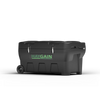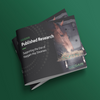Dr Andrea Ellis from Unequi Ltd, is a nutritionist specialised in food intake behaviour. In this article Dr Ellis discusses the stress and unwanted behaviours that are often linked with feed times and how we can  reduce them.
reduce them.
Here is a familiar situation/scene to the horse lover, either from the past (hopefully) or unfortunately still very much happening in the present: Every morning at 6.30, the yard staff arrive and start making up feed. The bins are nicely laid out next to each other, washed out the night before and a big chart on the wall highlights some individual nuances per horse. First some chaff, then a scoop of muesli/compound mix, some more individual supplements are put into the feedbins, a final drop of oil and then, for all a small scoop of Soaked Sugarbeet (put in water the night before). A quick stir and then the bins are stacked up on a trolley in order of their arrival at the stables. Meanwhile, rather than hearing nothing but the serene silence of an early morning, with a small ‘chorus’ of birds welcoming the new day, a small riot seems to have broken out in the stable yard outside. The dawn chorus/explosion of 20 hungry horses, waiting for their breakfast. There is whinnying and kicking, pushing and knocking, pawing, walking and pacing, headshaking and occasional lunging at anyone that happens to be passing by. Sounds familiar? Sounds stressful? It is.
A scene like this certainly never occurs in the horses’ natural environment. Naturally horses are ‘slow feeders’ – they spread their feeding bouts fairly evenly over 24 hours, spending around 10-14 hours on foraging behaviour. This changes somewhat according to weather and time of year. There are up to 10-15 separate feeding bouts throughout a 24 hour period, and very rarely will horses stop foraging for more than 3 hours at a time. Even veterinarians accept that a horse that has not received any food for more than 4 hours (day our night) will be moving into a ‘fasting’ state. In contrast horses are often fed in three distinct feeding periods when stabled. The Figure below shows the natural feeding pattern of horses in green, and a traditional feeding-management system of stabled horses.

Figure 1. Natural feeding pattern of free living horses versus Feeding pattern of stables horses (receiving a concentrate feed 3 x per day, followed by forage)(Source: Ellis, 2017 unequi.co.uk, adapted from Ellis,2010)
From this Figure it is clear that feed intake times are considerably reduced if we just go by the forage that we offer horses and especially at night a fasting period of 7-9 hours may be forced on horses, which is against their natural feeding pattern. Therefore the latest recommendations for optimum feeding of horses state that horses should be allowed to spend 10-12 hours on foraging behaviour, evenly spread across 24 hours.
But horses will not just ‘rest’ in prolonged non-feeding periods. They will do everything they can to carry out their ‘behavioural urge’ to fulfil foraging behaviour and this includes coprophagy, bedding eating (shavings, hemp, earth), woodchewing and even rug chewing.
This image shows a horse practicing coprophagy = eating own faeces, in order to gain enough fibre and increase time spent on foraging behaviour.
A study carried out in the Netherlands in stabled horse highlights this 'urge to chew' and 'forage' (Ellis et al., 2006). In this study 18 Warmblood horses were kept on a low forage diet (6 kg conc., 4 kg haylage) and 18 horses on a high forage diet (2 kg conc., 9 kg haylage) of equal overall energy content for a period of 4 months. The horses on the low forage diet spent a significant amount of time on foraging in bedding (woodshavings) and many developed regular coprophagic (faeces eating) behaviour. Both groups spent additional time on foraging behaviour in the stable, which balanced out to a very similar overall daily time spent on food intake behaviour, at an average of 8-10 hours (Figure 2)
Figure 2 The amount of time 2 groups of horses spent on food intake behaviour when fed on high or low fibre diets. The dark bars show how many hours stabled horses on a high fibre diet (HF) spent on feeding behaviour and the light bars show the time budget of horses on a traditional high concentrate diet (LF)1.
This urge for feed intake explains the high levels of agitation prior to feeding times in stabled horses. Unlike in nature, they have to wait for their food, they hear noises associated with the arrival of feed stuffs, and they have to wait their turn as their neighbours receive their ration before themselves. This triggers their ‘flight and fight’ nervous system into action, releasing adrenalin and increasing heart rates. This agitation leads to a state of high arousal, leading to the kicking, calling and locomotive behaviours we can observe. During this process some horses will also show aggression towards their neighbour and passers-by.
Good feed management systems try to reduce periods of fasting. There are various ways of achieving this:
One is of course to keep horses outside for as long as possible and if kept indoors to feed forage ad libitum, while avoiding concentrate meals.
In addition, feeding the final forage as late as possible in the evening and starting the day with forage (rather than a con centrate feed) as early as possible in the morning is one way of reducing feed-time anxiety.
centrate feed) as early as possible in the morning is one way of reducing feed-time anxiety.
Replacing concentrates with good quality forage increases feed intake time.
Slowing feed intake down is an excellent way to prolong feeding times and reduce ‘re-feeding’ stress.
The slow feeder from Haygain will help you with this. Find out more.
References
1 Ellis, A. D. (2010) Biological basis of behaviour and Feed Intake, In: A.D. Ellis, A.C. Longland, M. Coenen and N. Miraglia (2010) The impact of Nutrition on the Health and Welfare of Horses, EAAP Publication No. 128, Wageningen Academic Publishers, pp. 53-74
2 Ellis, A. D., Fell, M., Luck, K., Gill, L., Owen, H., Briars, H., Barfoot, C. and Harris, P. 2015. Effect of forage presentation on feed intake behaviour in stabled horses. Applied Animal Behaviour Science, Applied Animal Behaviour Science 165 (2015) 88–94 doi:10.1016/j.applanim.2015.01.010
3 Harris, P.A., Ellis, A.D., M.J.Fradinho, A.Jansson, V.Julliand, N.Luthersson, A.S.Santos and I. Vervuert. 2016. Feeding conserved forage to horses: recent advances and recommendations; Animal





















